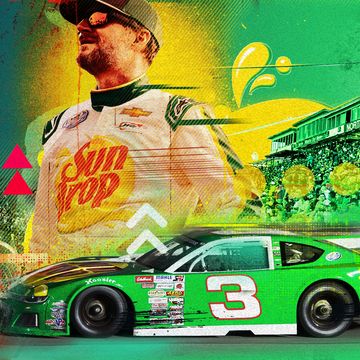This is about something very American. In the United States (and Canada and Mexico), pickup trucks aren’t mere tools, but aspirations. The boss drives a pickup here, and the boss’s boss does too. Pickups in North America are status symbols, family heirlooms, and beloved companions. And the all-electric F-150 Lightning adds environmental virtue beyond that. Plus, it’s about the quickest brick Ford has ever thrown.
“We’re investing in [internal-combustion engine] segments where we’re dominant and where we think, as competitors leave the segments, we can actually grow,” Ford CEO Jim Farley told Fox Business in September. “I find it intriguing that we’re portraying the future of our industry as monolithic. That’s not how it goes. That’s not how it’s going to manifest itself.”
The new Lightning is appreciated within a line of personal-use, occasionally high-performance pickups: from the cushy 1955 Chevrolet Cameo to Dodge’s rowdy 1978 Lil’ Red Express and on to the insane turbocharged 1991 GMC Syclone, the 2004 V-10-powered Ram SRT-10, and the two Fords that previously wore the Lightning name—where some utility is forsaken for looks, luxury, acceleration, and audacity.
Deceptively, the new Lightning wears F-150 skin. The aluminum cab and body pieces port from Ford’s best-selling F-series more or less intact. This isn’t Tesla’s someday Cybertruck doorstop moon buggy or the ludicrously large Hummer EV bent on domination. If an observer doesn’t know the Lightning’s discreet styling cues, it swims anonymously amid the traffic stream.
Under that mild-mannered costume, however, is a Kryptonian thing. It uses a conventional-style steel ladder frame, but instead of the rear leaf springs and solid axle used on full-size Ford trucks since 1917, there are independent control arms and coil springs at each corner (the current F-150 Raptor also uses coils). Between the frame rails, where conventional F-150s put engine, transmission, driveshaft, exhaust system, and fuel tank, there’s a tray of batteries and electric motors between both the front and rear pairs of wheels.
Combine the Lightning’s two three-phase fixed-magnet motors, and monster torque is available to push (and pull) the more than 6800 pounds of unladen truck. The majority of Lightnings (like the one tested here) come equipped with the 131-kWh extended-range battery. That’s up from the standard battery pack’s 98-kWh load of zap.
Electric motors make the same torque from the moment their rotor starts moving within their stator. So, no matter the battery pack, there’s a massive 775 lb-ft available in the Lightning. That’s 55 percent more than the 500 lb-ft available from the 3.5-liter twin-turbo V-6, the torquiest non-Raptor version of the F-150 with solely an internal-combustion engine. The F-150 Hybrid, which pairs that turbo V-6 with a supplementary electric motor and battery pack, runs at a stated 570 lb-ft of peak torque.
Because the extended-range batteries discharge more efficiently than the standard pack, the base Lightning is rated at 452 hp, while the higher-capacity model gets 580 hp. Ford claims a range of 230 miles for the standard Lightning and 320 miles for the extended-range in XLT and Lariat trims. Go for the high-zooty Platinum model, and that figure drops to 300. Ford claims it takes eight hours to recharge the battery from 15 to 100 percent using the 80-amp home charge station that comes with extended-range trucks. That drops to a claimed 41 minutes (to charge from 15 to 80 percent) on a 150-kW Level 3 charger.
Dear God and ghost of Henry Ford, this thing is quick. Our testing saw an extended range, 6855-pound F-150 Lightning Platinum absolutely blitz to 60 mph in 4.0 seconds flat. Consider this: The 450-hp 2021 Raptor needs 5.2 seconds to reach 60 mph. The only quicker trucks are the mighty Ram TRX with its supercharged Hemi V-8, which reached 60 mph in just 3.7 seconds, and the 835-hp, 7135-pound Rivian R1T, which spat in the eye of physics with a 3.3-second 0–60-mph rip.
Ford Special Vehicle Team’s head engineer noted in 2009 that the Lightning hot-rod pickup had to die because there was no sustainable market for a high-performance, on-road pickup truck. And anyway, he said, they’d need 600 or more horsepower to deliver meaningful performance, given the weight of a full-size truck. So Ford took a hard left off-road with the Raptor, exiling the V-8-powered Lightnings to the Island of Misfit Toys. It’s an irony lost on no one that the Lightning has returned with almost 600 hp and absurd acceleration figures while wearing the cloak of environmental virtue, not performance.
As impressive as the Lightning’s initial acceleration is, its passing power is even more thrilling. At freeway speeds, the Lightning loafs along almost noiselessly. Slam the not-loud pedal, and the thing squats down and squirts forward as if it were auditioning to star as a fighter jet in the next Top Gun sequel. It’s not the astonishing vertebrae destruction that comes with the Tesla Model S Plaid, but it is leagues more dazzling than any other F-series.
Foundation Stock
The second-gen 2003 Lightning delivers things the new one can’t.
Nostalgia is a gooey thing. It presents a past more imagined than real—a vision through the Vaseline-covered corneas of youth. But seat time in Jesus Martinez’s 2003 Ford SVT F-150 Lightning merits some bygone myopia. The all-electric F-150 Lightning is quicker but not always better.
At 31, Martinez isn’t old enough to have driven his truck when it was new. Unencumbered by memories, he appreciates the pickup’s sensations as fresh things. “It’s all mechanical,” he explains. “That’s what’s so great about it.”
Running 100-plus-octane E85, the black Lightning ignites with a vivid whine from the M112 Roots-style supercharger. Approaching its 20th birthday, Martinez’s truck has, well, evolved a bit over the decades. The blower has overdriven pulleys, the intake is freer flowing, and there’s an aftermarket exhaust that sounds like it’s singing La Traviata in the exact key of a 5.4-liter 16-valve overhead-cam V-8.
The 2003 Lightning was the next-to-last year for this second generation, so it benefitted from an update for 2001, when it sprouted a new 90-mm mass air flow sensor and the final-drive ratio shortened to 3.73:1. That upped the engine’s output from 360 hp during 1999 and 2000 to 380 for models built between 2001 and 2004. The 0–60-mph romp took 5.2 seconds back then. That’s 1.2 seconds less rapid than its electric son, but it’s a fun 1.2 seconds.
Now a novelty, the old Lightning is what was once known as a regular-cab truck. “I like the cab,” Martinez shares. “It means I can tell people there’s no room for them to come along.”
When Ford’s SVT was a thing, all its vehicles wore white-face gauges that reverse-glowed at night. They are here in all their analog glory behind a steering wheel with a thin rim and an airbag the size of a large fanny pack. There’s even a column-mounted wand controlling the four-speed automatic transmission. “It’s a burnout machine,” Martinez says about his rear-drive, stepside beast.
Wearing Nitto tires on stock 18-inch wheels, the aged Lightning has presence and attitude. Some of the decoration is old school—like two-tone upholstery—but it’s not archaic. There’s badassery here, both intimidating and charming.
The suspension is stiff, and the hydraulically assisted steering is almost soulful in its communion with the front tires. Turn-in isn’t quick, but it is satisfying. The comfort comes from the sensations the truck generates, not those things from which it isolates the driver.
Roaring along the streets of Maywood, California—gateway to Vernon, the City of Commerce, and parts of Los Angeles—good things that have passed away from current trucks become obvious. This F-150’s cowl is low, and the hood drops away for better visibility. The dashboard doesn’t glow with massive screens but trusts the driver to interpret its info and read a map. It offers things no new truck maker is selling now.
Some mist in the eyes is okay.
More subtle is how differently the Lightning handles from other F-150s. Because the Lightning long, meaning things like four-wheelers or motorcycles will hang out onto the tailgate. Longer lumber loads will take a supply of red flags to mark the overhang.
With that in mind, the greater deficit is that as load increases, range takes a hit. That’s particularly true when towing. While extended-range Lightnings are rated at 1952 pounds of cargo capacity and 7700 pounds of towing ability (and up to 10,000 pounds with the Max Trailer Tow package), trips will have to be planned carefully. Car and Driver, our sister publication, hooked up a 6100-pound trailer and saw the Lightning’s range drop by more than half. Even more daunting, the indicated range calculated by the truck’s algorithm dropped from a predicted 288 miles to a mere 96. For cross-country towing adventures, the Lightning makes little sense.
As a machine for bouncing around town, taking the dogs along, or moving some stuff a short distance, the Lightning is fine. And with its large front trunk, it’s a great personal companion if it often runs unladen. It says all the right things about the boss who is driving it.
Still, at this point, before the last gas station closes and while there are things worth towing, more conventional F-150s will be a better choice for many buyers. The F-150 Hybrid looks like a solid compromise, considering it’s easy to refuel and carries a 25-mpg EPA fuel economy rating on both the highway and in the city.
Also, the Lightning isn’t cheap. From a base price of $54,769, including a $1795 destination charge, the 2022 XLT rose to $76,384 as driven. The Platinum track-test example cost a whopping $93,609. And with all the production already committed, dealers are getting a lot more. There’s something very American about that too.
John Pearley Huffman has been writing about cars since 1990 and is getting okay at it. Besides Car and Driver, his work has appeared in the New York Times and more than 100 automotive publications and websites. A graduate of UC Santa Barbara, he still lives near that campus with his wife and two children. He owns a pair of Toyota Tundras and two Siberian huskies. He used to have a Nova and a Camaro.






















